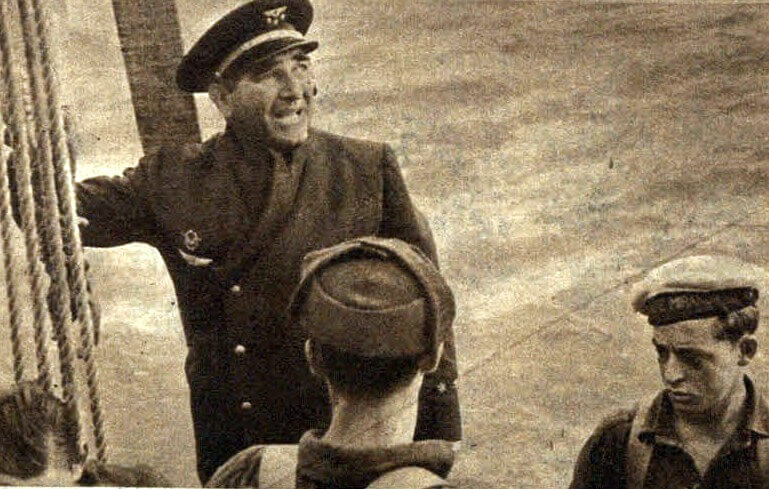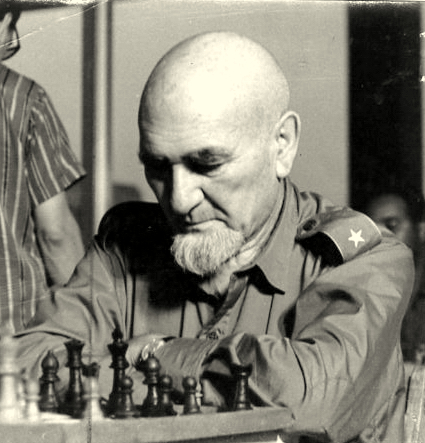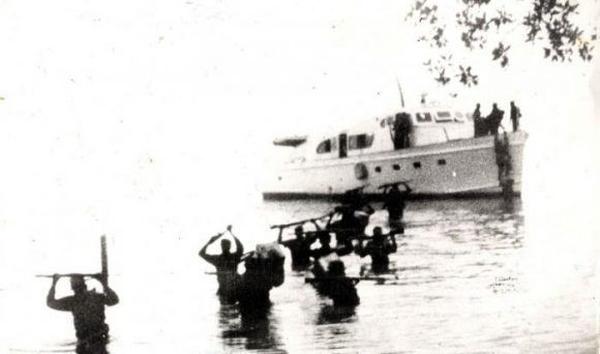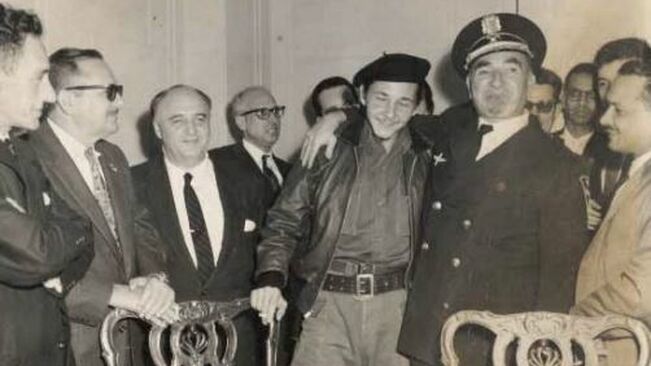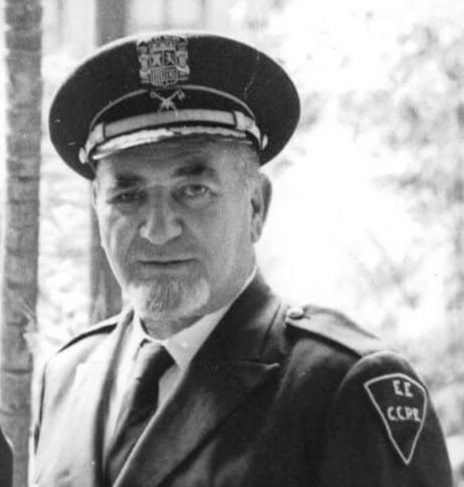As a soldier, Alberto Bayo fought in the Rif War and against the fascists in Spain. As a teacher, he taught Fidel, Che, and the revolutionaries who would one day liberate Cuba.
Contents
Introduction
In 1955 Alberto Bayo is a 63-year-old man drowning a previous life of spectacular warlike sorrows while managing a furniture store and teaching foreign languages in Mexico City. One day in July, someone rings his doorbell at 67 Country Club Avenue. When the one-eyed old man approaches the door he is greeted by two men, one of whom he knows. This man, Peña, says: “General Alberto Bayo, this is Fidel Castro. He has just arrived from Cuba, and he wants to meet you.” [1]
Fidel was not yet the Latin American hero, let alone a victorious revolutionary. Owing to an unsuccessful assault against the Moncada barracks in Santiago de Cuba, his name had been featured in newspaper headlines, but it had been two years since these had faded. General Bayo, however, remembers the name. He’s curious about what comes next.
“I want you to join us to coordinate an armed operation with the goal of overthrowing the tyrant of Cuba, Sergeant Fulgencio Batista,” says Fidel to his old compatriot, demandingly. “When I have the men and the funds to buy a boat I will form a militia, land in Cuba, and overthrow Batista. I want you to lend us a hand by teaching guerrilla tactics to my future soldiers.” [2]
General Bayo agrees. Perhaps he imagines that the round-faced young man is yet another dreamer; that he will come to his senses and give up on his heroic plans if he’s lucky, or die as he puts them into practice if he’s not. Within a few months, however, the young man returns and rings the bell again. He’s gathered the necessary men and funds, and he’s come to collect his promise from Alberto Bayo.
About a year later, aboard an old yacht, Fidel and his small army will set out on a journey that will forever change Latin American history.
Quixote’s Solitude
Alberto Bayo Giroud was born on 27 March 1892, in the Cuban province of Camagüey. The son of a Spanish father, he left the island at the age of six to study, first in Europe and then in the United States. From 1912 to 1915 he trained to become a pilot at the Madrid Military Aviation School, and fought in Morocco from 1917 to 1927. It was in this African country, as a member of the Spanish Legion, supporting the metropolis during the Rif War (1920-1927), that he faced the troops of Muhammad ibn Abd al-Karim al-Khattabi. [3] This was his first encounter with an art he would, in time, master: guerrilla warfare.
In Africa a hundred times our regular units attempted to surround our enemies in order to capture them. We would form opposing flanks, but by the time our ranks closed in on each other, we would find to our astonishment that the enemy troops had already disappeared. This experience, repeated time and time again, made me realize that, if they have the support of the peasantry, guerilla men are invincible. [4]
Bayo ended up developing great sympathy for the cause of the Rifian rebels, and he turned this experience into a book, Dos años en Gomara. Upon returning to Spain, he joined the Anti-Fascist Republican Military Union (UMRA), a clandestine organization founded by Lieutenant Colonel Ernesto Carratalá to oppose the right-wing Spanish Military Union (UME). General Francisco Franco, Bayo’s superior in the Rif War, had not yet come to power, but the stench of gunpowder and blood, prelude to the Spanish Civil War, was already in the air.
When the fascist Nationalists declare themselves against the coalition Republican government in July 1936, then-Captain Bayo proposes to lead a campaign to liberate the islands fallen under fascist rule: Formentera, Ibiza, and Majorca. He explains the strategic importance of the islands for the anti-fascist cause in a series of documents:
The Balearic Islands […] are situated in the Mediterranean between Italy and Spain, and thus would enable the [Francoist] rebels to receive excellent help and great support, since it’s not farfetched to imagine that the fascists might one day receive covert assistance from the Italians. These islands would serve as a stepping stone from which we would be constantly harassed and threatened. [5]
Bayo leaves aboard the destroyer Almirante Miranda in Porto de Maó, in Menorca, with about 3,000 men. He intends to disembark on Majorca, the largest of the Balearics, on 16 August 1936, at dawn. The day of the operation the sea is restless, and just before heading inland on speedboats, Bayo makes a speech saying that the only privilege he wants to enjoy is to be the first to set foot on the island before liberating it. Approaching the shore, he throws himself from the launch into the sea, and swims with his left hand; his right, lifted above water, holds his pistol. He sets his feet on the island at 6:30 AM.
Bayo was half-right: the Spanish fascists would indeed receive support from their Italian counterparts. However, this happens much sooner than he anticipated — they would prevent the conquest he intended to lead. Italian air support arrives only 11 days later, on August 27, and soon shoots down the small amphibious planes on which the Republicans were counting. On 12 September 1936, after three weeks of fighting, the battle is lost. The island would remain a fascist military base for the rest of the war.
In 1985, Don Jaime Farré Tur, at the time one of many young fighters under Bayo, in a series of extended interviews with chronicler Rafael Massanet, speculates reasons for this military failure. In his view Bayo was naive, and the top echelons of anti-fascist leadership lacked political vision. Republicans in Madrid, underestimating the threat of war, suspiciously eyed the operation as a covert expansionist tactic on the part of their allies in Catalonia. Meanwhile, underestimating the importance of the Balearics, Catalonians followed Madrid’s lead and offered only a half-hearted commitment. The officers and soldiers, in turn, displayed marked indiscipline. [6]
He did what he believed he had to do, but they deceived him from above and disobeyed him from below. Therein lies his tragedy; therein the great solitude of the man who knows that he cannot trust anybody, who holds in his hands the enterprise of his dreams, only to see it vanish through his fingers like a handful of dust. If I knew how to cry, my friend, I would cry for Alberto Bayo. [7]
Upon his return to Barcelona, Bayo is interrogated and tried by the Militia Committee. He is accused of ineptitude and cowardice, but is found not guilty. With Spain at war, he relocates to the frontlines in Madrid. The Expeditionary Army of Africa, a branch of the Spanish Army created to face the Rifian tribes, is, at the time, set to the purpose of conquering Madrid. Bayo proposes to organize small groups, armed with guerilla training, against them. According to Manuel Cruells, the logic was as follows:
They wanted to shift from regular warfare to irregular warfare, at least as long as their units were at disadvantage against a well-supplied army with control of entire operational structures. [8]
In other words, Bayo wanted to bring the Rif War to Madrid, in order to force the Expeditionary Army to repeat past mistakes such as dividing itself into flanks only to fail to capture vanishing foes. However, Bayo’s initiative was boycotted by the minister Indalecio Prieto, who went so far as to impose house arrest on the aviator for the publication of his booklet La guerra será de los guerrilleros.
Years later, in 1938, Bayo is finally allowed to form a guerrilla corps, but it was too late. The war ends in 1939 and he is evacuated to France. There, he performs some counterespionage work on behalf of the Allies. [9] He later spends a year in Cuba, and then moves to Mexico. In 1944 he publishes his recollection of the aforementioned landing, Mi desembarco en Mallorca.
Throughout the next decade he will work as a professor of languages at the Universidad Latinoamericana, at the School of Military Mechanics of Aviation in Guadalajara, and as the owner of a furniture shop. He will train Nicaraguan guerrillas — who name him a general — as well as Costa Rican ones, and maintain active contact with groups involved in the Caribbean Legion.
This renown is precisely what led to that fateful 1955 encounter with Fidel at his doorstep, and a promise of training yet to be fulfilled.
A Cuban Landing
Upon Fidel’s return, Bayo promises Fidel three hours of military training a day. “No, General Bayo, that won’t do. We want you all day. You must get rid of every last one of your chores. What do you want a furniture store for anyway, if very shortly you’ll be living with us in the golden island where we were both born, freed from the tyrant ruling over it?”, Fidel replies. [10]
Though Bayo is already 64, Fidel’s stubbornness is contagious. Bayo sells his shop and gives up his post in order to train the future guerrillas every day for six months. The student-rebels are first divided into groups of ten or twelve in several houses in Mexico City, and receive classes of theory. As the conceptual lessons come to an end, under Fidel’s orders, Bayo scouts for a ranch where they can undergo practical military training. They find the perfect property in the municipality of Chalco, just over an hour away from Mexico City. It is a large piece of land, approximately 200 hectares, in the middle of a mountainous and arid region, owned by a former combatant of the Mexican Revolution who doesn’t even know what those Cubans will use the land for.
Training at the Santa Rosa ranch begins in May 1956. The guerrillas get up at 5 AM, clean up their quarters, and have breakfast. Then come military exercises, the handling and cleaning of weapons, grenade throwing, and self-defense. [11] There are also occasional evening sessions, with marches starting at 8 PM, lasting 5 to 7 hours. Bayo followed his manual 150 Questions to a Guerrilla to the letter:
[The guerilla fighter] will engage in even longer marches until reaching a total of fifteen hours duration with only a short rest of ten minutes every four hours; besides, he will practice night marches of seven hours, at least. [12]
Fidel, who already had some military experience under his belt, stays in Mexico City with companions such as Ciro Redondo, Jesús Reyes and Héctor Aldama, in order to take care of the logistics and supplies for the camp as well as preparations for the landing in Cuba. However, from time to time he goes to the ranch to get some lessons. Che Guevara takes part in all the training sessions, and despite being the chief of staff at the camp, he finds time for a few chess games with General Bayo, who in turn is on a strict diet to prepare for the days he will fight in Cuba.
The future expeditionaries, however, are already under the watchful eye of Batista’s intelligence in Mexico, as well as of the country’s secret police. On June 1, the Naval Attaché of the Cuban Embassy, Nicolás Cartaya Gómez, sends a confidential report to the island, notifying them that Fidel’s group has completed its shooting practice and that there are rumors that they will soon launch their revolution. This is information is not quite correct: the first group of guerrillas instead sets up camps in the hills around the property in order to get used to the lifestyle they will face over the next several years. The second group of fighters arrives at the ranch in mid-June, so that there are about 30 men on the property in total. Only days later, on June 21, they are all arrested. However, as luck would have it, those who carry it out are men from the Mexican Federal Police, who initially believe they are dealing with a group of smugglers. The police operation proceeds in stages, and both Fidel and Che are detained along with 20 other Cubans, but Bayo escapes. About a month later, these captives are released, and the mission acquires a renewed sense of urgency. [13]
On 25 November 1956 at dawn, 82 revolutionaries trained by Bayo depart Tuxpan, Mexico, on the yacht Granma. They leave behind several fighters, among them the one-eyed old man who had so diligently instructed them on the art of war. Bayo, depressed, relates the aftermath of this stunt:
When the dozen patriots who remained in Mexico realized the mission was underway and that we were not a part of it, a wave of wrath, indignation, despair, hatred, revenge, rage, fury and every other associated emotion led them to curse every member of every family of those headed to Cuba on the Granma. […] Not once did I imagine they’d landlock me after 24 days of starvation and 63 days of endless pursuit by the Mexican police. [14]
The revolutionaries land in Cuba a week later, on December 2. Two years thence they’ll be launching their final offensive against the Batista regime, inaugurating the first socialist revolution in the Americas.
Upon learning of their triumph, the aviator would gush:
My heart leapt out of my chest. You see, my students learned my lessons so well that now it’s Fidel who can teach me! I want to see Che Guevara, Camilo, and Raulito so that they can tell me how they managed to learn to fight in the cities, because — I confess — it wasn’t I who taught them that. [15] [16]
And Che would reply in kind, in a preface to the old man’s recollections:
I consider it an honor to contribute some lines to the preface of the memoirs of this gladiator who refused to resign himself to old age. About General Bayo, a modern Quixote who only fears from death that it might not allow him to see his homeland liberated, I can say that he is my teacher. [17]
Bayo would continue playing a role in revolutions in the region, training guerrillas against the Trujillo and Somoza dictatorships. Che Guevara eventually met Bayo’s old rival al-Khattabi in El Cairo in 1959. [18]
Conclusion
Throughout his life Alberto Bayo continuously failed in his military adventures. However, he never failed to learn from his defeats. He learned from the humiliations imposed on him by the troops of Abd al-Karim al-Khattabi not only the form of the guerrillas, but also their spirit of freedom, which moved him to become a discreet admirer of his former enemies. He was also frustrated in his attempt to expel the fascists from the Balearic Islands, harvesting bitter lessons from a disastrous landing. He roamed the world — a student in America, a Spanish fighter in Africa, an anti-fascist in Spain, a spy in France, a teacher in Mexico — and this prepared him to become something he probably did not expect: the mentor of a small group of guerrillas that would liberate his own homeland, which he had abandoned in early childhood. Death did not prevent this Quixote from seeing it freed.
Alberto Bayo, the soldier whose crooked gaze always sought out the right side of history, died on 4 August 1967, in Havana, a Commander of the Revolutionary Armed Forces of Cuba.
[1] Antonio Palerm, “Alberto Bayo, maestro de guerrilleros” (2013). Le Monde. [web] [web]
[2] Antonio Palerm, “Alberto Bayo, maestro de guerrilleros” (2013). Le Monde. [web] [web]
[3] Antonio Palerm, “Alberto Bayo, maestro de guerrilleros” (2013). Le Monde. [web] [web]
[4] Alberto Bayo, Mi aporte a la Revolución Cubana (1960). [web]
[5] Rafael Ferrer Massanet, “Capitán Bayo” (III, 1985-10-05), Perlas y Cuevas. [web]
[6] Rafael Ferrer Massanet, “Capitán Bayo” (XI, 1986-01-25), Perlas y Cuevas. [web]
[7] Rafael Ferrer Massanet, “Capitán Bayo” (V, 1985-11-02) Perlas y Cuevas. [web]
[8] Manuel Cruells, La expedición a Mallorca, 1936 (1971).
[9] Manuel P. Villatoro, 2020. “Alberto Bayo: el legionario español que fue un héroe de la II República y adiestró a Fidel Castro”. ABC Historia. [web]
[10] Antonio Palerm, “Alberto Bayo, maestro de guerrilleros” (2013). Le Monde. [web] [web]
[11] Jan Martínez Ahrens, 2015-05-19. “Fidel Castro e Che Guevara, detidos”. El País Brasil. [web]
[12] Alberto Bayo, 150 Questions for a Guerilla (1955). Question 15. Hosted at the CIA Reading Room. [web]
[13] Declassified documents of this operation exist, and they shed some light onto why the rebels were released. It seems that either they weren’t deemed a serious threat (the justification for the raid was targeting contraband, and on this score it was underwhelming), or some “Machiavellian” expectation of future utility on the part of Mexico’s spy chief Fernando Gutiérrez Barrios. [19]
[14] Alberto Bayo, Mi aporte a la Revolución Cubana (1960). [web]
[15] Manuel P. Villatoro, 2020. “Alberto Bayo: el legionario español que fue un héroe de la II República y adiestró a Fidel Castro”. ABC Historia. [web]
[16] About Raúl Castro, Fidel’s brother, Bayo had some interesting things to say: “If these mad assassins ever manage to snuff out Fidel Castro, imagining that this sacrifice will finally eclipse the Cuban revolution, they haven’t the slightest idea of what kind of man would take the torch right after him. Raúl is Fidel multiplied by two when it comes to energy, inflexibility, and tenacity.” [20]
[17] Manuel P. Villatoro, 2020. “Alberto Bayo: el legionario español que fue un héroe de la II República y adiestró a Fidel Castro”. ABC Historia. [web]
[18] Antonio Palerm, “Alberto Bayo, maestro de guerrilleros” (2013). Le Monde. [web] [web]
[19] Jan Martínez Ahrens, 2015-05-19. “Fidel Castro e Che Guevara, detidos”. El País Brasil. [web]
[20] Antonio Palerm, “Alberto Bayo, maestro de guerrilleros” (2013). Le Monde. [web] [web]
